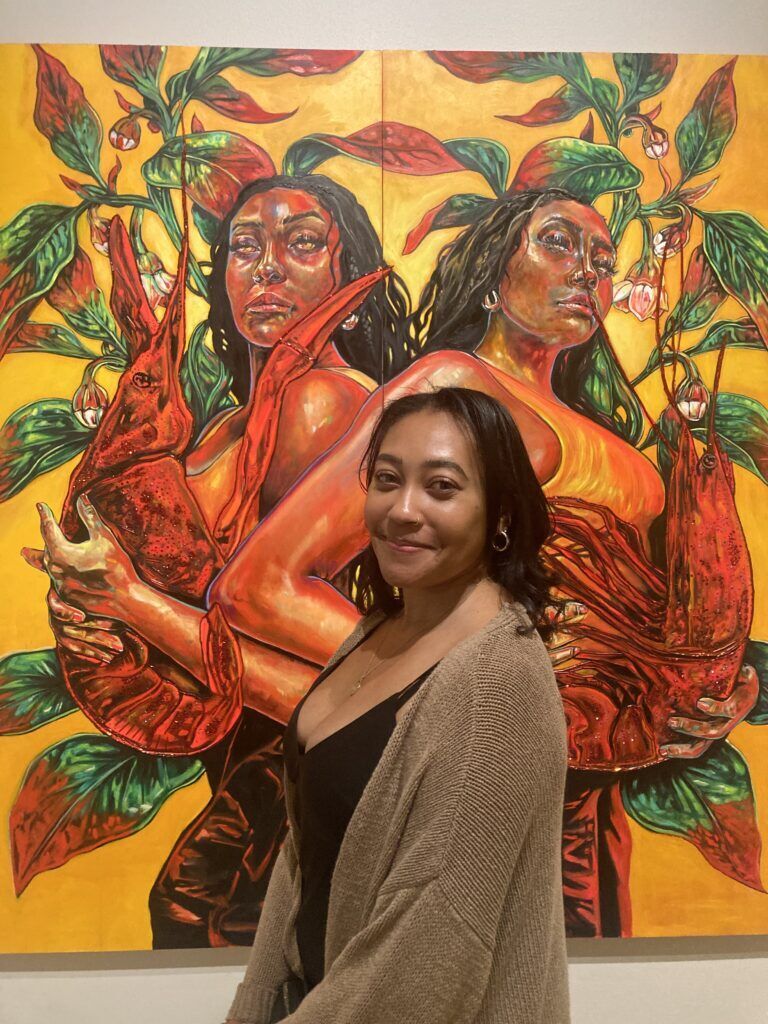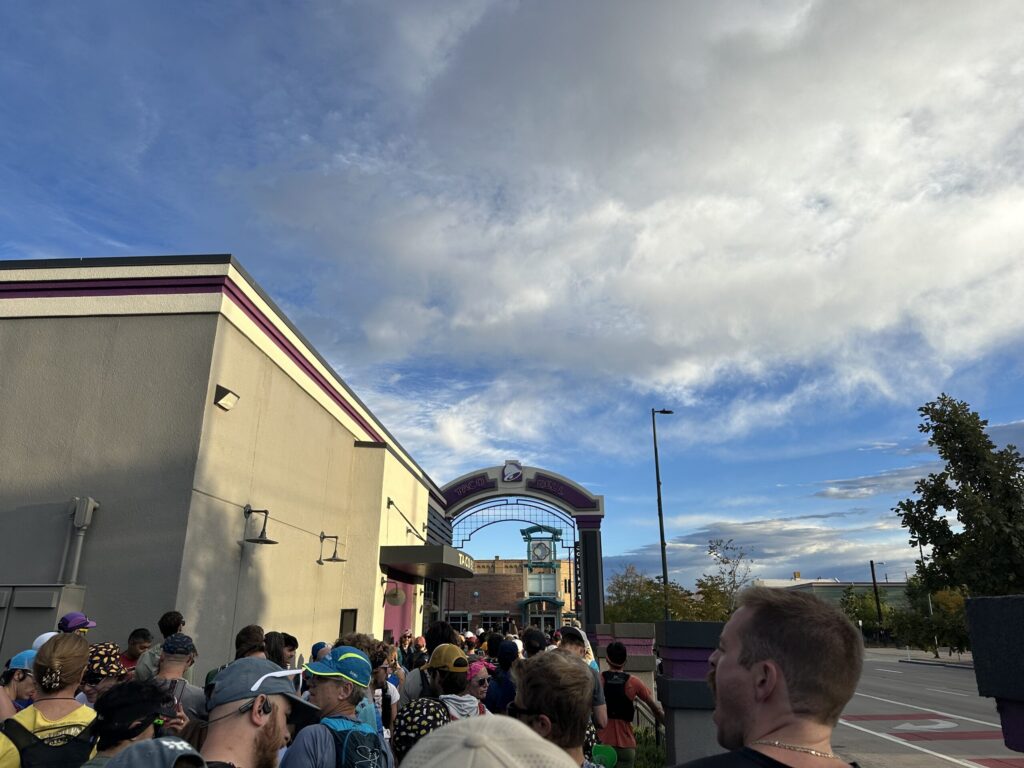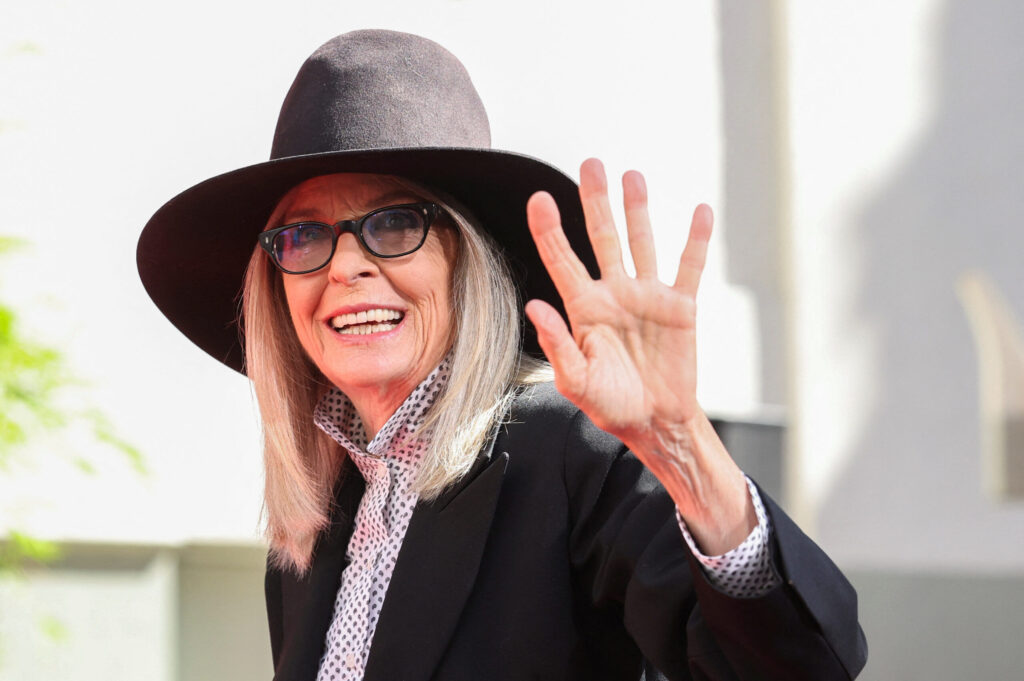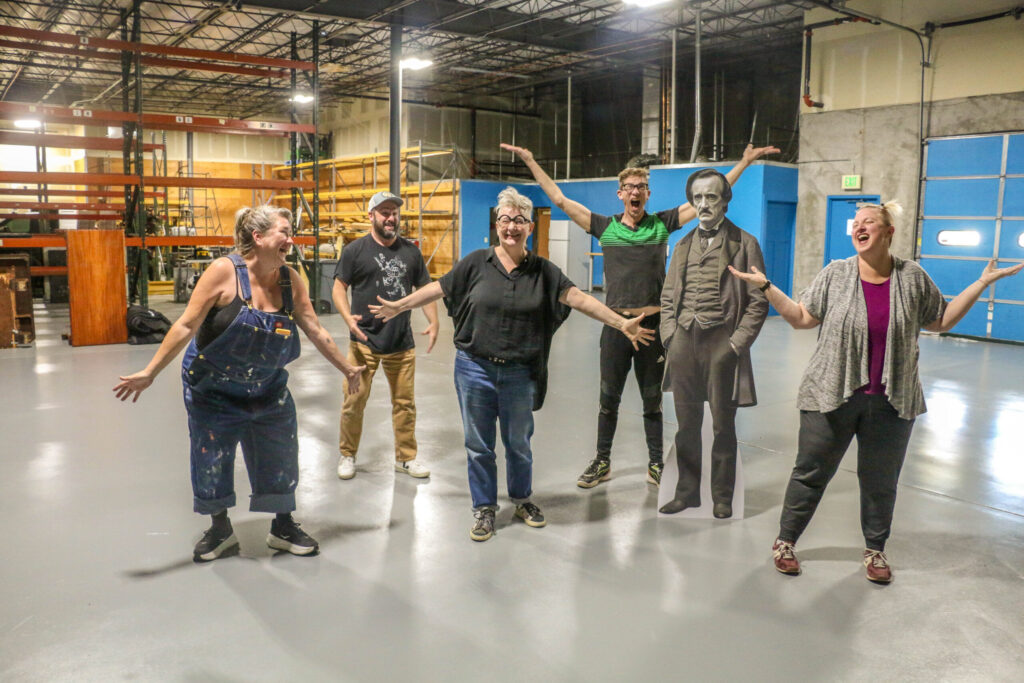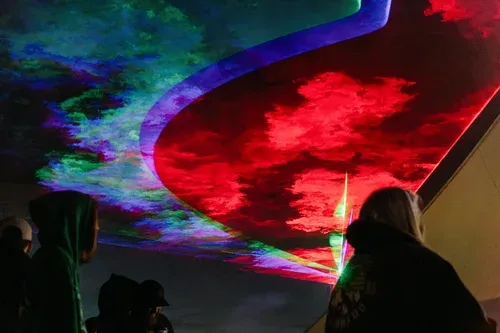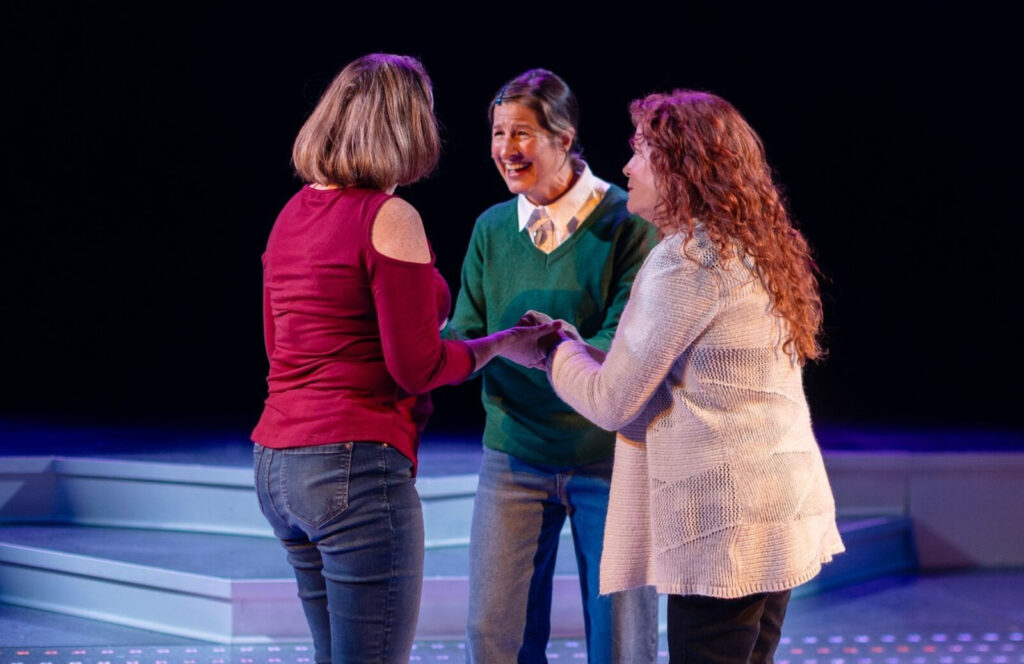Feast your eyes on Jazz Holmes’ first solo exhibit ‘Nourishing’ at Denver Botanic Gardens
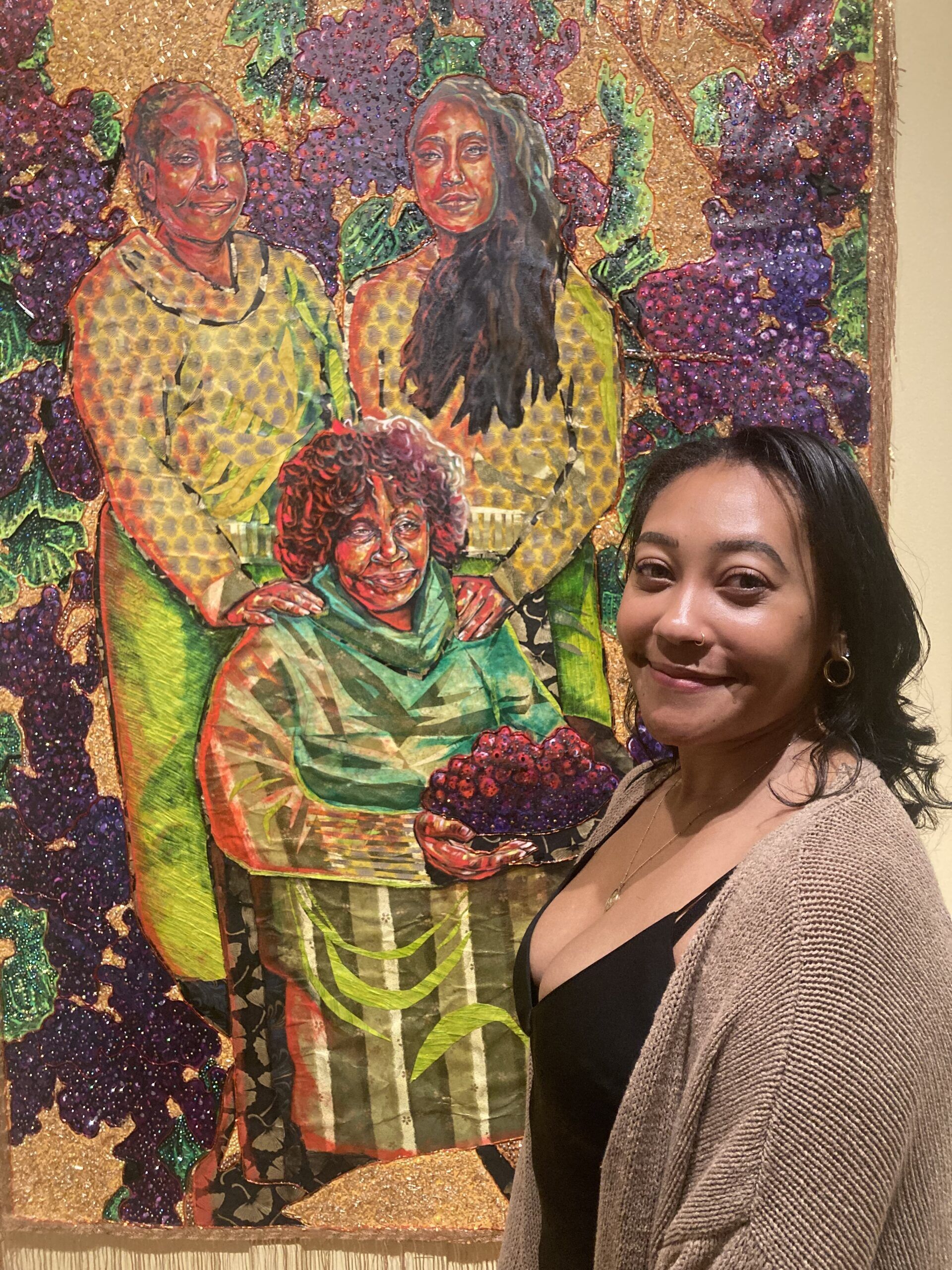
In early October, Jazz Holmes opened her very first solo art exhibition titled “Nourished” at Denver Botanic Gardens. Shortly thereafter, the artist traveled to Florida for the funeral of her grandmother, Lynda Jackson James.
“She was the matriarch of the family, so this show is definitely dedicated to her,” Holmes said in a walk-through of her vivid, mouth-watering-eye-candy artworks depicting people and plants affiliated with Creole cuisine.
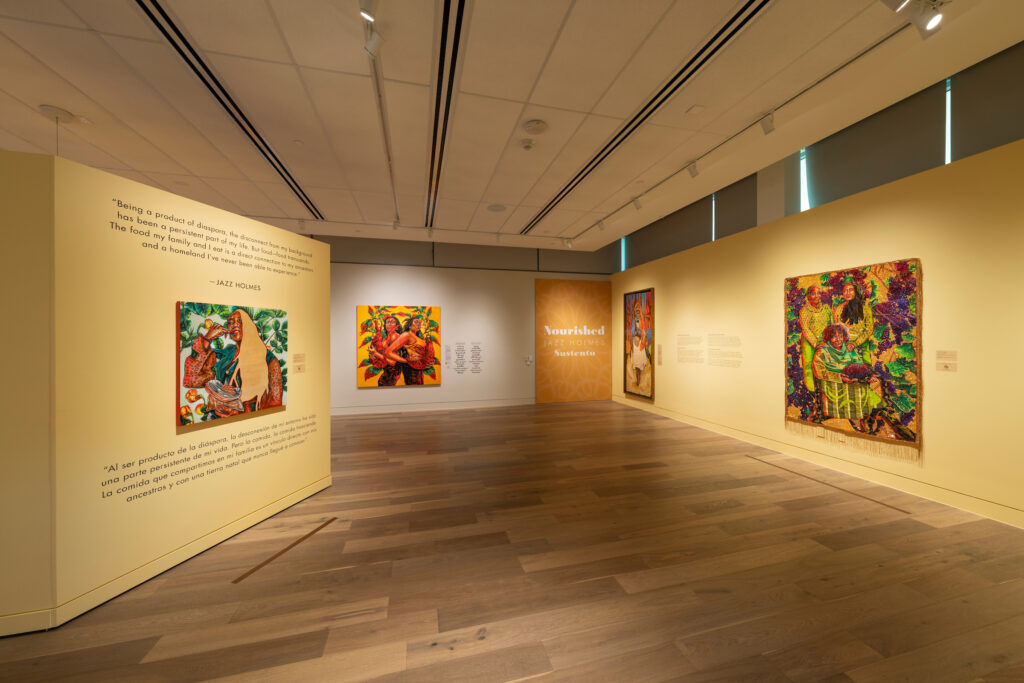
One of the large-scale mixed media artworks depicts the artist pictured with her grandmother, mother and homegrown grapes.
“We were always called the three musketeers in the family. We were best friends, and she used to grow muscadine grapes in her backyard. I just wanted to celebrate my grandmother for passing down all of the recipes and all of her knowledge to my mom and to me. She got to see this before she left us. That’s all that matters to me,” said Holmes, who acknowledged the imprints her grandmother left upon her life and her art.
“She loved to knit and quilt,” said Holmes. “I had this whole box of silver beads that my grandma had found at a thrift store and given me. My grandma and all of her sisters always were covered rhinestones. I had those beads for about two years and never used them.”
Then, Holmes had a flash of inspiration while working on a large painting of her grandma holding a catfish.
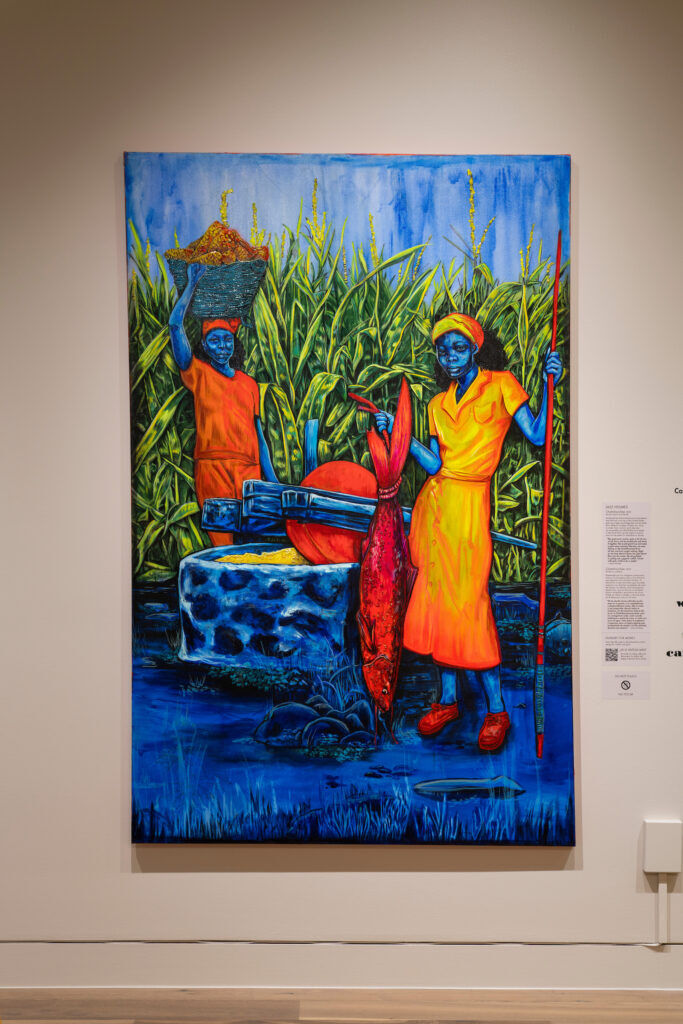
She said: “It was just flat to me. And then I woke up and looked at it and I thought ‘that needs something to celebrate it.’ So I started drawing with the beads, is what I like to call it. And that became like a signature of mine.”
A transplant from the South to Colorado
“My grandma had eight brothers and seven sisters, and they all had their own kind of farms, sharecropping land,” Holmes said. “Some of them lived in Louisiana, some of them lived in Georgia, some of them lived in North Carolina, and I moved around like a lot, so I just say I’m from the South.”
Holmes came to Colorado eight years ago to earn her Masters degree at Colorado State University.
“I chose Colorado because of nature,” the artist said. “I love nature, and I love agriculture, and the ranching culture here is different from the South.”
Holmes’ show lists the plant ingredients in the Creole dishes depicted in her art. Even her given name, Jasmine, is a plant, and she took an early interest in the Plant Kingdom.
‘I’ve always been that drawing kid’
Holmes also leaned into art at an early age.
“I’ve always been that drawing kid. It’s always been in my blood to create something whether that’s drawing, painting, whatever I can get my hands on,” she said. “I grew up with two really nerdy video game designer parents. My mother was an illustrator, and my dad worked for Marvel. I learned to draw the human figure from my parents, and I grew up drawing a lot of video games anime and cartoons.”
Her parents also exposed Holmes to the natural world.
“Every summer they would uproot me and put me in this agricultural deep south area where I had nothing, so I was always drawing everything that was around me. I was studying the plants and the agriculture whenever I would go away for the summer so that influenced what I liked to draw.”
Her interest and application paid off. In 2020, DBG selected Holmes as one of the first Landline artists in residence.
“Holmes’ work tells a story about the many ways food nourishes us, not only providing our bodies with nutrients, but also connecting us to our families and ancestors through shared recipes and collective history,” said Moira Casey, DBG assistant curator of exhibitions. “Food is a universal basic human need, but the unique ways humans have cultivated and cooked different plants across cultures and time is what makes this story so powerful.”
Immigrants introduced ingredients
While Southerners often use their garden-grown ingredients, Holmes emphasized that immigrants introduced many key ingredients into Creole cuisine, a mix of French, Spanish, Italian, African, and Native American heritage.
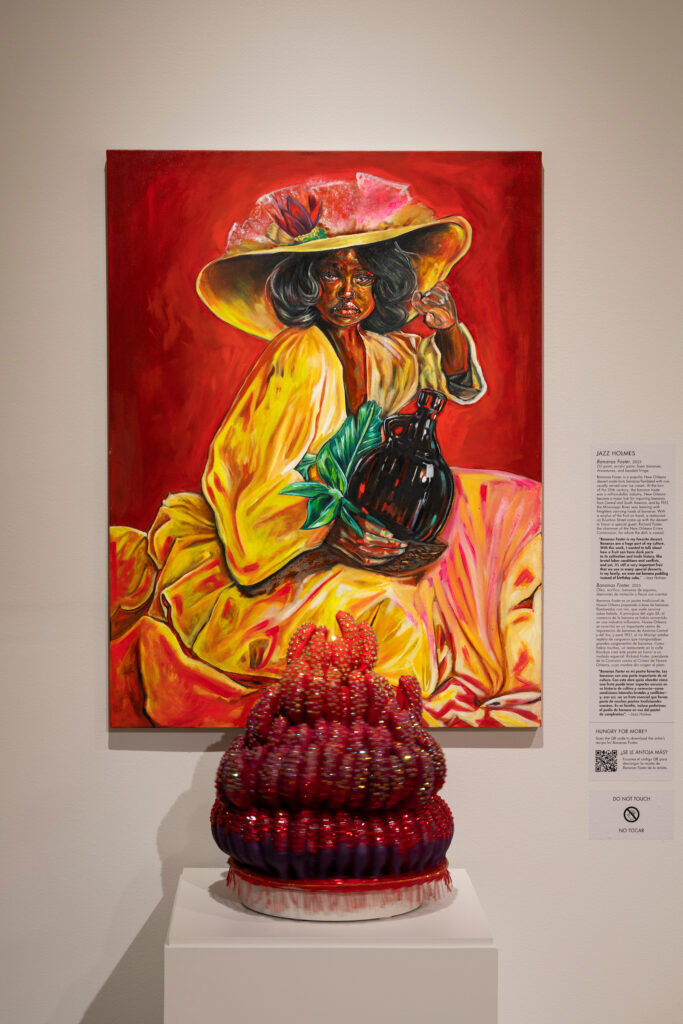
“Tomatoes weren’t really used until a lot of Italian immigrants traded them. It’s always a mixture depending on who’s around, and that’s what makes it amazing, like the melting pot of the South,” Holmes said.
“Creole food is seen as elevated. I focus so much on Southern culture, because people see it as lower than, so I want to bring it into a space like this and celebrate it and make it look maximalist,” Holmes said. “And I’m the same way when it comes to Southern food, because there aren’t a lot of Michelin star Southern restaurants, even though everyone loves to eat Southern food.”
An especially eye-catching self-portrait depict two versions of artist — one embracing a giant crawfish, the other a giant shrimp. The painting is a nod, Holmes said, to the family’s hotly contested etouffee cook-off which, for the record, the artist recently won. The painting’s hot reds and oranges appear mouth-wateringly spicey.
“I’m connected to West Africa, and I was looking at how food was brought over from West Africa to here, and how we never gave up certain ingredients, like okra. It’s not native to America. We brought okra over so that we wouldn’t lose our connection,” said Holmes. “The use of peanuts and other ingredients made me realize the resilience and the celebratory nature of my culture rather than all pain. So, that’s one reason why the rhinestones and why there’s so much color.”
Holmes paints many colors of a Black person
In Holmes’ self-portraits and paintings of her Creole family, skin tones include vibrant blues, reds, greens and violets. The bold and bright palette calls to mind the expressive works by Thomas Evans, also known as I Am Detour, another Denver-based artist using vivid hues in faces of color. As it turns out, the two artists are friends and work in the same studio space.
“Jasmine’s work is amazing and soulful,” Evans said. “One aspect about her work that I really love is the natural fusion of beads and other items that she incorporates into the composition. It feels seamless and subtle while still adding a dynamic look and feel to the portraits that she paints. I love her approach to including the culinary arts into the conversation. It’s an especially unique fusion of expression. I’m always excited to see her works as she seems to be always creating.”
Food bridges language barriers
Holmes drew comparisons between the visual arts and the culinary arts.
“I think of ingredients as my materials,” she said. “In my process, the way that I cook, I’m experimenting just like I do when it comes to art — thinking of texture, thinking of color, thinking of presentation. Taste is a vehicle for experience, so I think art and cooking overlap a lot and they should be put together a lot more.”
Holmes’ exhibit reminds visitors of the ways food brings people together across generations, across cultures and locations.
“Food is a type of language, just like music. With music, you don’t need to speak to someone else. You can just speak through the sound you’re making, and a lot of cultures can come together around music. Food is the same way.”
The bitterness of Bananas Foster
“Nourished” includes Holmes’ multimedia depiction of a popular Southern dessert: Bananas Foster. But along with the sweetness the artist included a salty, sour, bitter taste, too. Beneath her beaded and collaged painting, Holmes installed a sculptural bunch of rhinestone bedazzled bananas rotating as if on a lazy Susan. The bananas are not yellow, but red.
“Blood red,” said Holmes, “because in some places, people are not paid to pick bananas. It’s still slave labor.” She noted a list of other crops involving less than equitable labor practices.
Holmes said: “We need to be mindful of all the food we eat.”
Visitors can feast their eyes on “Nourished,” through March 22, 2026. Holmes will present an artist’s talk in the Ladd Family Gallery, Sunday, December 7, noon to 1 p.m. The talk is free with admission and registration. More information: http://jazzholmes.com and The Denver Botanic Gardens website.
